The Myth of Kashi
The exact origin of Kashi remains shrouded in mystery, as there is no archaeological or carbon-dated evidence to pinpoint its beginning. The first historical reference to Kashi appears in the Skanda Purana, specifically in the Kashi Khanda (the section on Kashi). The Skanda Purana is one of the 18 Mahāpurāṇas, a series of ancient Hindu texts that were verbally transmitted by spiritual teachers to their disciples during the Satya Yuga, the first of the four Yugas in Hindu cosmology.
Even if we assume that Kashi was first mentioned near the end of the Satya Yuga, the city would still date back to at least 2,163,102 BCE, as that is when the following Yuga, called the Treta Yuga, is believed to have begun. Mark Twain, after visiting the city in 1897, famously stated, “Benaras (Kashi) is older than history, older than tradition, older even than legend, and looks twice as old as all of them put together.”
Many ancient texts describe Kashi as the embodiment of Lord Shiva, with the original town planning reflecting how Lord Shiva envisioned the physical manifestation of the Supreme Soul (Paramatma). Today, scholars—including archaeologists, religious researchers, palaeographers, and epigraphers—continue to work on rediscovering Kashi’s ancient records and establishing connections between the past and present. This ongoing investigation requires both an open mind and a scientific approach.
It is widely believed that Kashi was the first city established after the great cosmic dissolution (Mahāpralaya), marking the beginning of the current cycle of creation (Shrishti), preservation (Sthiti), and destruction (Samhar).
Are Kashi & Varanasi the same?
The Vedas, which are the foundational texts of Hinduism, revere and worship Agni (Fire) as a divine element, associated with Surya (the Sun). Agni is considered a gift from the Sun to humanity, enabling us to calibrate our lives. The Sun provides warmth and light—both essential for sustaining life—and has the power to destroy all that exists.
In Sanskrit, Kashi means light, brightness, or the concentration of cosmic light. Therefore, Kashi, as the name of the first city in the world, symbolizes one of the two great gifts bestowed upon humanity by the Supreme Lord. For this reason, it is often referred to as the “City of Light.”
Kashi is known by many names, each with spiritual, symbolic, or historical significance. Some of these names include Kashika (the city of light), Rudravasa (abode of Rudra, another name for Shiva), and Avimukta (the city never forsaken by Lord Shiva). Each of these names reflects Kashi’s deep spiritual roots.
The name Varanasi refers to the geographical features of the city, specifically the two streams of the Ganges River—Varuna and Assi—that flow through it. Many cities during the medieval period were named after natural landmarks, so it is likely that Kashi’s name evolved in a similar manner. The names Banaras and Benaras are anglicized versions of Banaras, a colloquial term that became widely used in Western literature and references.
What is the Spiritual Importance of Kashi
Kashi is often referred to as the spiritual heart of India. Nestled on the banks of the sacred Ganges River, this ancient city has been a major pilgrimage destination for millennia. To the outsider, it might seem chaotic, intense, and overwhelming. However, for those who approach with an open mind and a sense of reverence, Varanasi offers an unparalleled experience of connection to the divine.
Here’s why Kashi holds the title of the center of spirituality.
1: Kashi: A Place Where Life and Death Meet
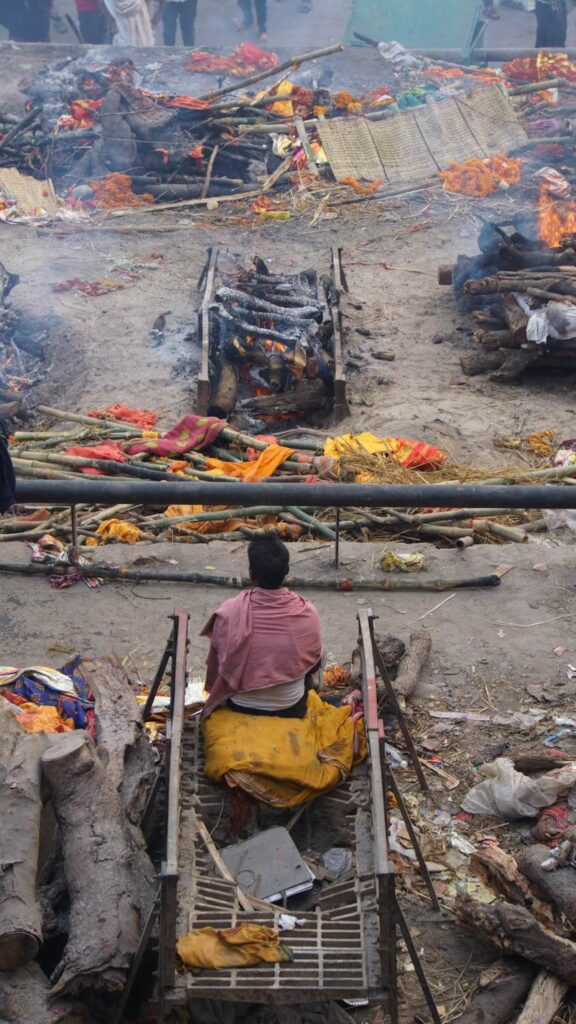
At first glance, Kashi may appear as a bustling, noisy, and chaotic place to visit. Yet it is precisely these contrasts that give the city its spiritual depth.
The Ghats—steps leading to the river—are where people gather for rituals, serving as the stage where life and death coexist. A visitor witnessing a body being cremated while people nearby go about their daily routines comes to realize how fragile life is and how futile attachment can be (Vairagya).
Just as life begins in water (the embryo), it is completed at the Ghats, which stand as the doorstep to the River Ganges—marking the cycle of birth, death, and rebirth.
Many believe that those who die in the city or are cremated here attain liberation from the cycle of rebirth. While we humbly acknowledge our limited understanding of this process—since it seemingly contradicts the principle of Karma Phal Siddhant (the Law of Karma)—we do believe that being in Kashi offers the soul an opportunity to transcend to a higher plane. It is akin to joining a prestigious university that opens doors to greater opportunities for learning, though it doesn’t guarantee success.
2: Shiva’s Kashi
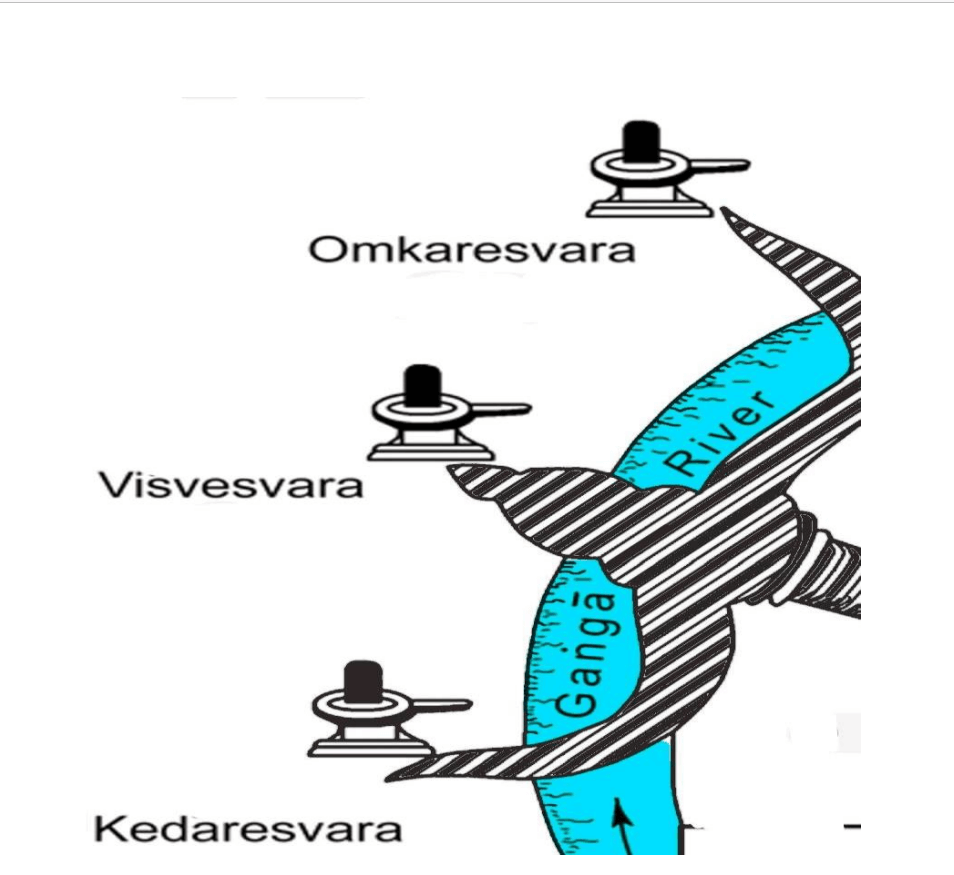
The Skanda Purana mentions that there are (or were) 511 Shiva lingams in the Kashi Kshetra (region), categorized into a five-tier hierarchy. These five types of lingams are:
- Self-born Lingams (Svayambhu)
- These lingams are said to have come into existence on their own, or to have self-manifested. Across India, 68 such lingams have been identified, of which 12 are considered the most significant. These 12 represent the twelve months of the year, twelve dominions, and twelve body parts. They are believed to inherently embody the power of Shiva, so they do not require a Prana Pratishtha (ritual consecration). One such lingam, Visvesvara, is located in the Kashi Vishwanath Temple. In ancient times, Visvesvara jyotirlinga was revered by Pasupati and Saiva-Siddhanta siddha yogis for Srividya Tantra Sadhana and Kundalini Awakening.
- Planetary Lingams (Lingams Installed by the Gods)
- These seven lingams—representing the Sun, Moon, Mars, Mercury, Jupiter, Venus, and Saturn—complete the cycle of weekly pilgrimages. Additionally, it is believed that 46 more lingams were established by the Gods in and around the vicinity of Kashi.
- Lingams Installed by Great Saints
- There are 47 lingams established by revered Indian sages such as Agastya, Atri, Kanadi, Gautam, Jabali, Jaimini, Durvasa, Narada, Pulatsya, Parashara, Bharadvaja, Bhrigu, Yajnavalakya, Vyasa, Vashishtha, Valmiki, Shaunaka, and others. While not all of these lingams remain visible today, many disciples and archaeologists are diligently working to rediscover and restore the greatness of Kashi. Among them, seven lingams representing the Sapta Rishis are particularly important, with pilgrims regularly visiting them.
- Lingams Installed by Shiva’s Ganas
- Forty-five lingams in the vicinity of Varanasi were established by Shiva’s Ganas (followers). However, only eight of these lingams, those installed by Shiva’s attendants, are commonly visited in pilgrimage. Among these, the Dandapani lingam is the most prominent and frequently visited.
- Spatially Transposed Lingams
- This category includes two subtypes of lingams:
- Light-reflecting Lingams (Jyotir-lingams):
- There are 12 Jyotir-lingams across India, and one of them is located in Kashi.
- Replicated Lingams (Pratirupa-lingams):
- Sixty-five Pratirupa-lingams were transposed in Varanasi, symbolizing different lingams from various holy sites in India. Of these, only 45 still exist in Varanasi, while the rest have either vanished or lost their identity.
3: Kashi: Town Planning as a Cosmic Layout
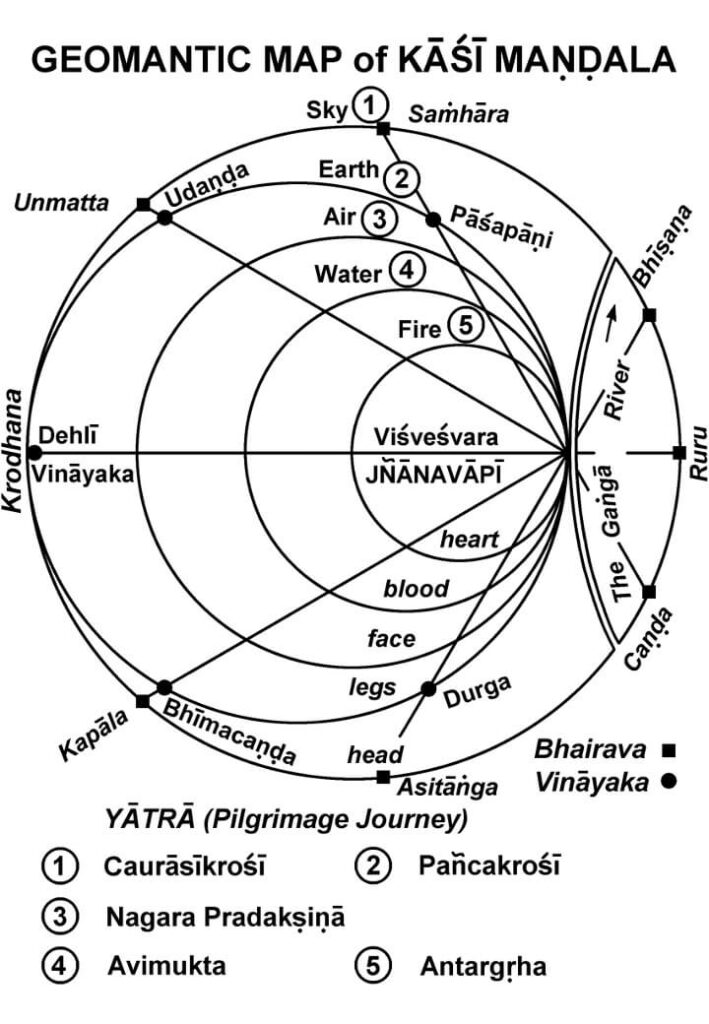
The first city created after the great cosmic dissolution (Mahapralaya) could not have been designed ordinarily. And if it is to serve as the physical manifestation of the Supreme Soul, its design must be extraordinary. The original Kashi Kshetra was indeed planned in a way that made it the center of cosmic spirituality. It is a place where the material environment reflects the parallelism between the macrocosm, mesocosm, and microcosm, uniting them to form a sacred spatial system. In other words, Kashi acts as the mesocosm (the platform) that connects the macrocosm (the cosmos, or the heavens, or the Supreme Soul) with the microcosm (the human body).
The five elements—sky, air, fire, earth, and water—complete the macrocosm. Kashi interlinks these five layers with the three cosmic levels, as detailed in the table below.
The Skanda Purana mentions that Kashi rests on Lord Shiva’s trident (Trishul). While this may not be literally true, as one cannot see a physical trident or a place perched atop it, a closer study of the town’s layout reveals three sacred segments, each with an inner circuit (Antargriha) and its associated patron deity. These three circuits are: Omkareshvara in the north, Vishveshvara in the center, and Kedareshvara in the south. The location of each original Shiva lingam—not just these three—along with the positioning of idols such as Ganesha or Nandi, is carefully planned, and each placement has a deep connection with the cosmos.
4: Kashi: The archetype of an All-India Holy Place
Between the 6th and 13th centuries, a cultural initiative began that aimed to transpose the spiritual essence of sacred sites across India into Kashi.
As part of this movement, Kashi was given representations of major holy places from all directions. The four Dhams (God’s abodes) — Badrinath in the north, Jagannath Puri in the east, Dwarka in the west, and Rameshwaram in the south — were symbolically initiated in Kashi around the central loci of their presiding deities, at Matha Ghat (Badrinath), Rama Ghat (Puri), Shankudhara (Dwarka), and Mir Ghat (Rameshwaram).
In addition, other sacred places from across India were symbolically represented in various parts of the city. For example, Kedarnath was mirrored at Kedar Ghat, Mathura at Bakaria Kund or Nakkhi Ghat, Prayag (Allahabad) at Dashashvamedha Ghat, Kamaksha (Assam) at Kamachha, Kurukshetra at Kurukshetra Kund near Assi, and Manasarovar Lake at Manasarovar near Shyameshvara. This process of spatial transposition has reinforced Kashi’s position as the religio-cultural capital of India.
5: The Holy Ganga: The Lifeblood of Spirituality’
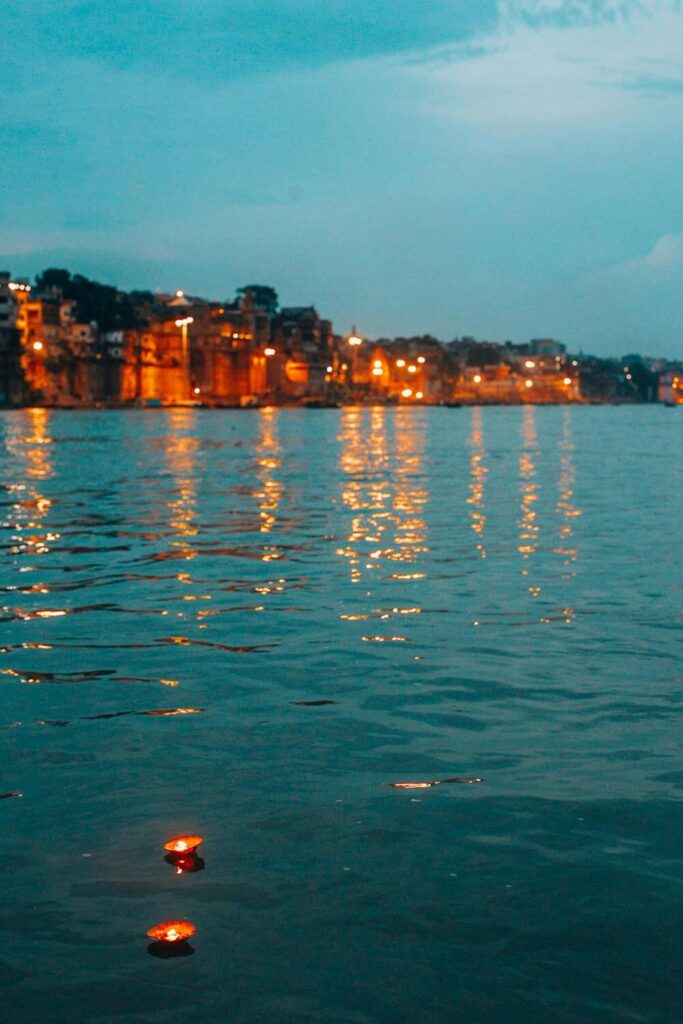
The Ganga is the eternal river that descended to Earth to offer salvation to human souls. Kashi’s iconic 84 ghats, which stretch along its 6.5 km (4 miles) riverfront, are celebrated by UNESCO. Please read here about Kashi riverfront on the tentative list of UNESCO World Heritage Sites. These ghats are the site of essential spiritual rituals, including funeral rites and cremation ceremonies.
It is believed that the foundations of all the Swayambhu Lingams are connected to the very course of the Ganga, making them inseparable. After all, the Holy Ganga is said to have emerged from Lord Shiva.
Among the ghats, five are considered the most sacred, known as the Panchatirths. These are mentioned in the Matsya Purana (from the last centuries of the 1st millennium BCE) and are:
- Assi Ghat – Where the Ganga meets the Assi River.
- Dashashvamedha Ghat – The most important of all, renowned for its daily Ganga Aarti ritual. This spectacular ceremony involves priests offering prayers and lighting lamps in tribute to the Ganges, creating a mesmerizing atmosphere of music, dance, and fire.
- Manikarnika Ghat – Known as the place where the cycle of birth and death ends, and a new one begins. It is where bodies are cremated, and the ashes are immersed in the Holy Ganga. Here, the concept of Vairagya (renunciation) becomes deeply tangible for those ready to embrace it.
- Panchaganga Ghat – Believed to be the confluence of five rivers: the Ganga, Yamuna, Sarasvati, Kirana, and the Dhutpapa (though only the Ganga is visible).
- Adi Keshava Ghat – One of the oldest sites mentioned in the Puranas, where Lord Vishnu is believed to have arrived when he first came to Kashi. It lies about 3.5 km east of Panchaganga Ghat and remains less crowded.
6: The Practices of Meditation and Yoga
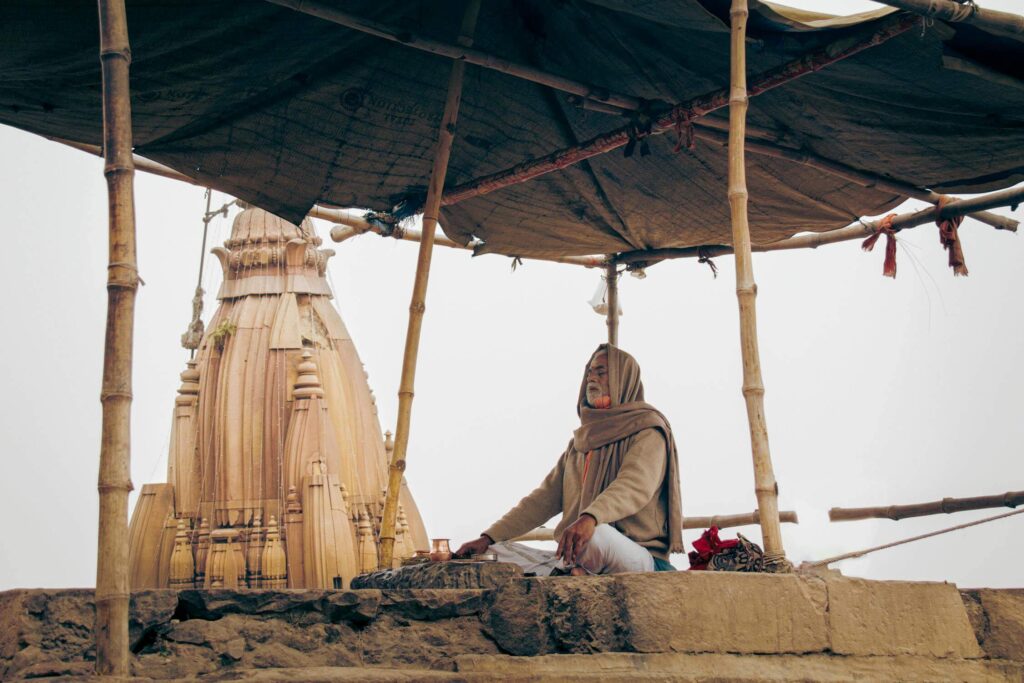
Spirituality in Kashi extends far beyond the walls of its temples and the rituals at its ghats; it is a living, breathing force that permeates the very streets of the city. Known for centuries as a spiritual epicenter, Varanasi has been a sanctuary for those seeking deeper meaning and connection. The city has long been a hub for meditation and yoga, drawing spiritual seekers from across the globe. People come to Kashi not only to witness its rituals but to engage directly in spiritual practices, enhance their meditation practices, and delve into the ancient wisdom that has shaped India’s spiritual traditions.
The narrow, winding streets of Varanasi are lined with ashrams, spiritual centers, and yoga institutes, where experienced teachers guide individuals on their path to self-awakening. These spiritual spaces offer both solace and transformative experiences, allowing seekers to connect with the timeless teachings of meditation, yoga, and mindfulness that have flourished in Kashi for millennia.
7: Spiritual Gurus & Their Connection to Kashi
Varanasi, one of the most spiritually significant cities in India, has long been a center for philosophical and spiritual teachings. Many revered gurus and saints have deep connections to this city, and their legacies continue to influence its spiritual landscape.
Adi Shankaracharya (8th Century)
Adi Shankaracharya, one of India’s most revered spiritual teachers, is known for consolidating the Advaita Vedanta philosophy. He played a pivotal role in establishing the worship of Shiva as the central practice in Kashi, further solidifying its status as a major spiritual hub. Shankaracharya also founded the famous Kashi Vishwanath Temple, dedicated to Lord Shiva, and established one of his four primary Mathas (monastic centers) in the city. His teachings and reforms continue to shape the spiritual fabric of Varanasi to this day.
Tulsidas (1511–1623)
Tulsidas, the author of the Hanuman Chalisa and Ramcharitmanas—two of the most widely read and recited texts in Hinduism—spent much of his life in Kashi. In fact, one of the ghats is named Tulsi Ghat in his honor. The Sankat Mochan Temple is the place where Tulsidas is said to have met Lord Hanuman face-to-face, who would visit him in disguise to listen to his recitations of the Ram Katha.
Sant Kabir (1398–1518)
Sant Kabir, a poet-saint and mystic, was born in Varanasi in the 15th century. Kabir’s devotional poetry, which blends elements of Hinduism and Islam, emphasizes the oneness of God. His radical teachings on love, devotion, and the rejection of ritualistic practices were groundbreaking at the time. Kabir’s legacy continues to resonate in Varanasi, especially in the Kabir Chaura locality, where his followers come to pay homage. His simple yet profound message of spirituality and devotion remains a powerful influence.
Lahiri Mahasaya (1828–1895)
Lahiri Mahasaya, a disciple of the great Mahavatar Babaji, is famous for demonstrating that spiritual attainment can be achieved while living as a householder, fully immersed in worldly life. He moved from West Bengal to Varanasi for his studies and later settled in the city. In 1862, Lahiri Mahasaya met Mahavatar Babaji in Ranikhet, Uttarakhand, and learned the ancient practice of Kriya Yoga. He spent the rest of his life meditating and teaching Kriya Yoga to his disciples, leaving a lasting spiritual legacy in Varanasi.
Swami Vivekananda (1863–1902)
Swami Vivekananda, the renowned monk and spiritual leader, is celebrated for his efforts to harmonize Eastern and Western philosophies. Though he was not born in Varanasi, he spent considerable time there during his spiritual journey. It was in Varanasi that he meditated and reflected on the teachings of India’s great spiritual masters. Vivekananda’s connection to the city, particularly through the Banaras Hindu University (BHU), is significant. BHU was inspired by his vision of integrating both academic learning and spirituality into a holistic educational model.
How to find Spiritual Enlightenment in Kashi

For beginners seeking spiritual enlightenment in Varanasi, it is essential to approach the experience with an open mind, free from prejudice or bias. Here are some ways to deepen your spiritual journey:
- Spend Time at the Ghats
- Take the time to visit as many ghats (steps leading to the river) as possible and observe the activities and rituals. Each ghat offers its own spiritual energy, and spending time there will help you connect with the essence of Varanasi.
- Take a Dip in the Holy Ganga
- When you feel ready, consider taking a dip in the sacred Ganges River. A bath in the Ganges is a symbolic act of surrender and offers a profound connection to the spiritual energy of Varanasi. It is believed to purify the soul and cleanse one’s sins.
- Attend the Ganga Aarti at Dashashwamedh Ghat
- One of the most spiritually charged experiences in Varanasi is attending the Ganga Aarti at Dashashwamedh Ghat. This powerful ritual invites visitors to reflect on the cycle of life and death, as well as the relationship between the self and the cosmos.
- Explore the Pilgrimage Routes
- Discover the spiritual essence of Varanasi by following the city’s pilgrimage routes. Many scholars, including those from Banaras Hindu University (BHU), are actively researching these paths and their significance. BHU is also a hub for spiritual and philosophical discussions, making it an ideal place for those seeking intellectual and spiritual growth. If possible, seek guidance from teachers and scholars at the university, as there are still many spiritual, tantric, and sacred mysteries to be unearthed.
- Practice Yoga and Meditation
- Varanasi is a renowned center for spiritual practices like yoga and meditation. The city has numerous ashrams and yoga centers where visitors can take courses designed to deepen spiritual awareness. These centers often combine physical exercises, breathing techniques, and guided meditation to help practitioners connect with their inner selves. Some ashrams offer extended stays for those wishing to delve deeper into yoga and meditation.
- Note: Always do thorough research before joining any course, as, unfortunately, not all centers are trustworthy. Scammers can exploit even the holiest places.
- Participate in Spiritual Discussions and Lectures
- Throughout Varanasi, spiritual leaders and scholars often host lectures on ancient Indian scriptures, philosophy, and meditation. These discourses are an excellent way to learn about the deeper teachings of Hinduism and other spiritual traditions. For international visitors, these lectures offer valuable insights into spiritual practices and ancient wisdom, leading to profound personal growth.
- Experience Dev Deepawli (Kartik Poornima)
- If you’re in Varanasi around November 15th, make sure to participate in Dev Deepawli. This spectacular event, organized at the ghats, engages the senses and can open doors to spiritual awakening.
Varanasi is more than just a tourist destination; it is a living spiritual experience. For seekers and international tourists, the city offers an opportunity to immerse yourself in its mystical energy. Whether by bathing in the Ganges, attending the Ganga Aarti, or meditating along the ghats, visitors can connect with a profound sense of peace and transformation that is uniquely Varanasi. The city’s temples, ashrams, and sacred sites invite visitors to explore both the external world and their inner selves, guiding them on a path toward spiritual fulfilment.
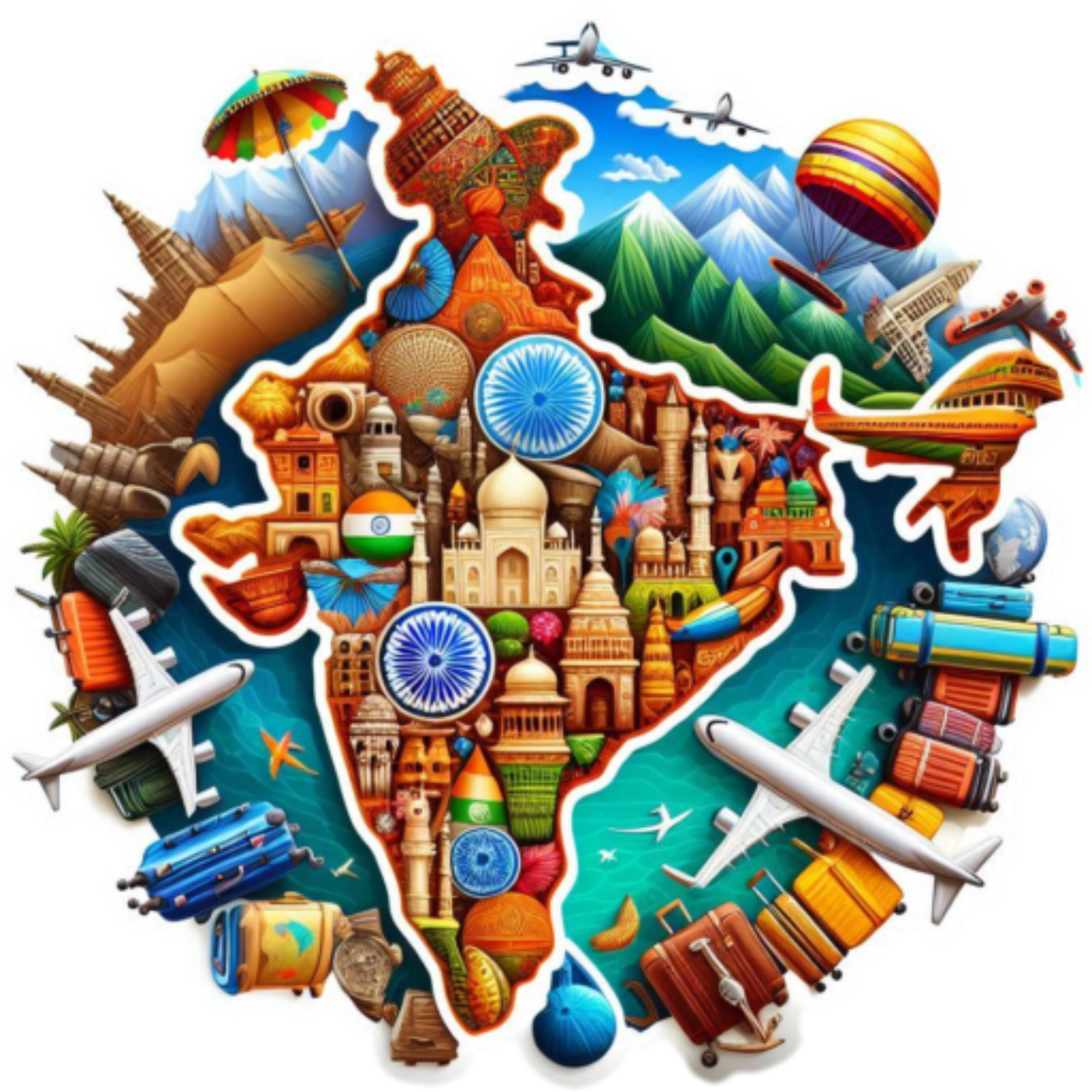
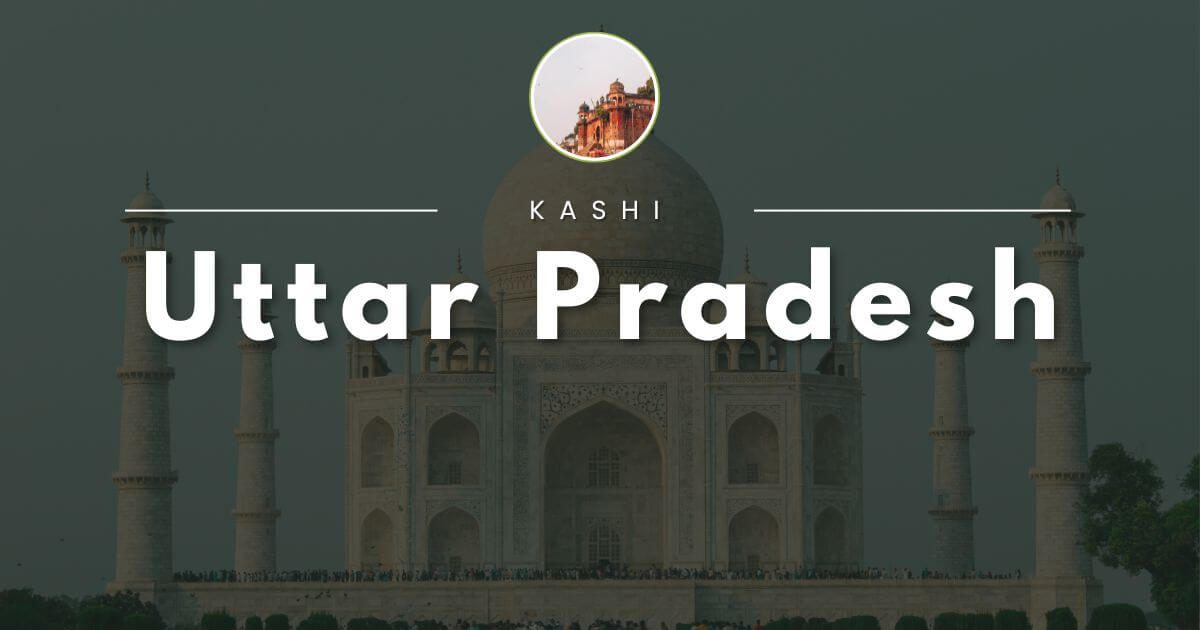

Pingback: Backpacking to India: Here's how to plan it well - Traveling to India?
Pingback: Know All About Lord Shiva's Blissful Spiritual Connection - Traveling to India?